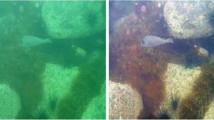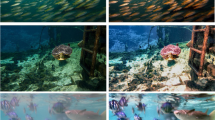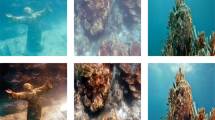Abstract
Underwater image and video enhancement task is of great significance for ocean exploration. Compared with a single image, underwater video enhancement is more susceptible to scene and light changes, which causes inconsistency between the frames of enhanced video. In this paper, we construct a high-quality dataset named UVE38K to establish a benchmark for underwater video enhancement, which consists of 50 real-world videos from various environments. To understand the difference in quality between underwater video frames. We propose a quality superiority decision network (QSDNet) to distinguish the high-quality and low-quality frames in enhanced videos. Our QSDNet can achieve an accuracy of 87.9%. We also propose two underwater video enhancement algorithms PUVE and BUVE for online and offline situations respectively. Experiments on the UVE38K dataset show that our methods outperform existing methods.













Similar content being viewed by others
Data Availability Statements
The datasets supporting the conclusions of this article are included within the article.
Notes
References
Abdul Ghani A S, Mat Isa N A (2015) Underwater image quality enhancement through integrated color model with rayleigh distribution. Appl Soft Comput 27:219–230
Akkaynak D, Treibitz T (2019) Sea-thru: a method for removing water from underwater images. In: IEEE Conference on computer vision and pattern recognition, pp 1682–1691
Ancuti C, Ancuti C O, Haber T, Bekaert P (2012) Enhancing underwater images and videos by fusion. In: IEEE Conference on computer vision and pattern recognition, pp 81–88
Anwar S, Li C (2020) Diving deeper into underwater image enhancement: a survey. Signal Process: Image Commun 89:115978
Anwar S, Li C, Porikli F (2018) Deep underwater image enhancement. arXiv:1807.03528
Bai L, Zhang W, Pan X, Zhao C (2020) Underwater image enhancement based on global and local equalization of histogram and dual-image multi-scale fusion. IEEE Access 8:128973–128990
Berman D, Levy D, Avidan S, Treibitz T (2020) Underwater single image color restoration using haze-lines and a new quantitative dataset. IEEE Trans Pattern Anal Mach Intell
Berman D, Treibitz T, Avidan S (2017) Diving into haze-lines: color restoration of underwater images. In: British machine vision conference
Boom B J, He J, Palazzo S, Huang P X, Beyan C, Chou H-M, Lin F-P, Spampinato C, Fisher R B (2014) A research tool for long-term and continuous analysis of fish assemblage in coral-reefs using underwater camera footage. Eco Inform 23(9):83–97
Buchsbaum G (1980) A spatial processor model for object colour perception. J Franklin Inst 310(1):1–26
Cao K, Peng Y, Cosman P C (2018) Underwater image restoration using deep networks to estimate background light and scene depth. In: IEEE Southwest symposium on image analysis and interpretation, pp 1–4
Carlevaris-Bianco N, Mohan A, Eustice R M (2010) Initial results in underwater single image dehazing. In: MTS/IEEE SEATTLE, pp 1–8
Chambah M, Semani D, Renouf A, Courtellemont P, Rizzi A (2003) Underwater color constancy: enhancement of automatic live fish recognition. In: Color imaging IX: processing, hardcopy, and applications, vol 5293, pp 157–168
Chiang J Y, Chen Y (2012) Underwater image enhancement by wavelength compensation and dehazing. IEEE Trans Image Process 21(4):1756–1769
Cutter G, Stierhoff K, Zeng J (2015) Automated detection of rockfish in unconstrained underwater videos using haar cascades and a new image dataset: labeled fishes in the wild. In: IEEE Winter applications and computer vision workshops, pp 57–62
Dai C, Lin M, Wu X, Wang Z, Guan Z (2020) Single underwater image restoration by decomposing curves of attenuating color. Opt Laser Technol 123:105947
Ding D, Wang W, Tong J, Gao X, Liu Z, Fang Y (2022) Biprediction-based video quality enhancement via learning. IEEE Trans Cybern 52(2):1207–1220
Drews P L J, Nascimento E R, Botelho S S C, Montenegro Campos M F (2016) Underwater depth estimation and image restoration based on single images. IEEE Comput Graphics Appl 36(2):24–35
Fabbri C, Islam M J, Sattar J (2018) Enhancing underwater imagery using generative adversarial networks. In: IEEE International conference on robotics and automation, pp 7159–7165
Fu X, Fan Z, Ling M, Huang Y, Ding X (2017) Two-step approach for single underwater image enhancement. In: International symposium on intelligent signal processing and communication systems , pp 789–794
Fu X, Zhuang P, Huang Y, Liao Y, Zhang X, Ding X (2014) A retinex-based enhancing approach for single underwater image. In: IEEE International conference on image processing, pp 4572–4576
Fu X, Cao X (2020) Underwater image enhancement with global–local networks and compressed-histogram equalization. Signal Process: Image Commun 86:115892
Ghani A S A, Isa N A M (2014) Underwater image quality enhancement through composition of dual-intensity images and rayleigh-stretching. In: IEEE International conference on consumer electronics. Berlin, pp 219–220
Guan Z, Xing Q, Xu M, Yang R, Liu T, Wang Z (2021) Mfqe 2.0: a new approach for multi-frame quality enhancement on compressed video. IEEE Trans Pattern Anal Mach Intell 43(3):949–963
He K, Sun J, Tang X (2011) Single image haze removal using dark channel prior. IEEE Trans Pattern Anal Mach Intell 33(12):2341–2353
He K, Zhang X, Ren S, Sun J (2016) Deep residual learning for image recognition. In: IEEE Conference on computer vision and pattern recognition, pp 770–778
Hou G, Zhao X, Pan Z, Yang H, Tan L, Li J (2020) Benchmarking underwater image enhancement and restoration, and beyond. IEEE Access 8:122078–122091
Hou G, Li J, Wang G, Yang H, Huang B, Pan Z (2020) A novel dark channel prior guided variational framework for underwater image restoration. J Vis Commun Image Represent 66:102732
Hou G, Pan Z, Wang G, Yang H, Duan J (2019) An efficient nonlocal variational method with application to underwater image restoration. Neurocomputing 369:106–121
Hou M, Liu R, Fan X, Luo Z (2018) Joint residual learning for underwater image enhancement. In: IEEE International conference on image processing, pp 4043–4047
Hu J, Jiang Q, Cong R, Gao W, Shao F (2021) Two-branch deep neural network for underwater image enhancement in hsv color space. IEEE Signal Process Lett 28:2152–2156
Huang D, Wang Y, Song W, Sequeira J, Mavromatis S (2018) Shallow-water image enhancement using relative global histogram stretching based on adaptive parameter acquisition. In: MultiMedia Modeling, pp 453–465
Iqbal K, Odetayo M, James A, Salam RA, Talib AZH (2010) Enhancing the low quality images using unsupervised colour correction method. In: IEEE International conference on systems, man and cybernetics, pp 1703–1709
Islam M J, Xia Y, Sattar J (2020) Fast underwater image enhancement for improved visual perception. IEEE Robot Autom Lett 5(2):3227–3234
Islam M J, Luo P, Sattar J (2020) Simultaneous enhancement and super-resolution of underwater imagery for improved visual perception. In: Robotics: science and systems
Jaffe J S (1990) Computer modeling and the design of optimal underwater imaging systems. IEEE J Oceanic Eng 15(2):101–111
Jian M, Qi Q, Dong J, Yin Y, Zhang W, Lam K (2017) The ouc-vision large-scale underwater image database. In: IEEE International conference on multimedia and expo, pp 1297–1302
Kashif I, Salam R A, Azam O, Talib A Z (2007) Underwater image enhancement using an integrated colour model. Iaeng Int J Comput Sci 34(2):239–244
Krizhevsky A, Sutskever I, Hinton G E (2012) Imagenet classification with deep convolutional neural networks. In: Advances in neural information processing systems, pp 1097–1105
Kumar N, Sardana H K, Shome S N (2019) Saliency based shape extraction of objects in unconstrained underwater environment. Multimed Tools Applic 78(11):15121–15139
Li C, Guo C, Ren W, Cong R, Hou J, Kwong S, Tao D (2020) An underwater image enhancement benchmark dataset and beyond. IEEE Trans Image Process 29:4376–4389
Li C, Guo J, Cong R, Pang Y, Wang B (2016) Underwater image enhancement by dehazing with minimum information loss and histogram distribution prior. IEEE Trans Image Process 25(12):5664–5677
Li C, Guo J, Guo C (2018) Emerging from water: underwater image color correction based on weakly supervised color transfer. IEEE Signal Process Lett 25(3):323–327
Li C, Quo J, Pang Y, Chen S, Wang J (2016) Single underwater image restoration by blue-green channels dehazing and red channel correction. In: IEEE International conference on acoustics, speech and signal processing, pp 1731–1735
Li C, Anwar S, Porikli F (2020) Underwater scene prior inspired deep underwater image and video enhancement. Pattern Recogn 98:107038
Li H, Li J, Wang W (2019) A fusion adversarial underwater image enhancement network with a public test dataset. arXiv:1906.06819
Li Y, Zhang Y, Xu X, He L, Serikawa S, Kim H (2019) Dust removal from high turbid underwater images using convolutional neural networks. Opti Laser Technol 110:2–6
Lin W H, Zhong J X, Liu S, Li T, Li G (2020) Roimix: proposal-fusion among multiple images for underwater object detection. In: IEEE International conference on acoustics, speech and signal processing, pp 2588–2592
Liu R, Fan X, Zhu M, Hou M, Luo Z (2020) Real-world underwater enhancement: challenges, benchmarks, and solutions under natural light. IEEE Trans Circuits Syst Video Technol 30(12):4861–4875
Liu X, Gao Z, Chen B M (2020) Mlfcgan: multilevel feature fusion-based conditional gan for underwater image color correction. IEEE Geosci Remote Sens Lett 17(9):1488–1492
Liu X, Gao Z, Chen B M (2021) Ipmgan: integrating physical model and generative adversarial network for underwater image enhancement. Neurocomputing 453:538–551
Liu C, Meng W (2010) Removal of water scattering. In: International conference on computer engineering and technology, vol 2, pp V2–35–V2–39
Lu J, Li N, Zhang S, Yu Z, Zheng H, Zheng B (2019) Multi-scale adversarial network for underwater image restoration. Opt Laser Technol 110:105–113
M Uplavikar P, Wu Z, Wang Z (2019) All-in-one underwater image enhancement using domain-adversarial learning. In: IEEE Conference on computer vision and pattern recognition workshops
McGlamery B L (1980) A computer model for underwater camera systems. In: Ocean Optics VI, vol 0208, pp 221–231
Mohd Azmi K Z, Abdul Ghani A S, Md Yusof Z, Ibrahim Z (2019) Natural-based underwater image color enhancement through fusion of swarm-intelligence algorithm. Appl Soft Comput 85:105810
Oleari F, Kallasi F, Rizzini D L, Aleotti J, Caselli S (2015) An underwater stereo vision system: from design to deployment and dataset acquisition. In: OCEANS, pp 1–6
Panetta K, Gao C, Agaian S (2016) Human-visual-system-inspired underwater image quality measures. IEEE J Oceanic Eng 41(3):541–551
Reinhard E, Adhikhmin M, Gooch B, Shirley P (2001) Color transfer between images. IEEE Comput Graphics Appl 21(5):34–41
Silberman N, Hoiem D, Kohli P, Fergus R (2012) Indoor segmentation and support inference from rgbd images. In: European conference on computer vision, pp 746–760
Simonyan K, Zisserman A (2015) Very deep convolutional networks for large-scale image ecognition. In: International conference on learning representations
Srividhya K, Ramya M M (2017) Accurate object recognition in the underwater images using learning algorithms and texture features. Multimed Tools Applic 76(24):25679–25695
Tang C, Von Lukas U F, Vahl M, Wang S, Wang Y, Tan M (2019) Efficient underwater image and video enhancement based on retinex. SIViP 13(5):1011–1018
Torres-Méndez L A, Dudek G (2005) Color correction of underwater images for aquatic robot inspection. In: Energy minimization methods in computer vision and pattern recognition. Springer, Berlin, pp 60–73
Trucco E, Olmos-Antillon A T (2006) Self-tuning underwater image restoration. IEEE J Oceanic Eng 31(2):511–519
Wang Y, Wu B (2010) Fast clear single underwater image. In: International conference on computational intelligence and software engineering, pp 1–4
Yang M, Hu J, Li C, Rohde G, Du Y, Hu K (2019) An in-depth survey of underwater image enhancement and restoration. IEEE Access 7:123638–123657
Yang M, Sowmya A (2015) An underwater color image quality evaluation metric. IEEE Trans Image Process 24(12):6062–6071
Yu H, Li X, Lou Q, Lei C, Liu Z (2020) Underwater image enhancement based on DCP and depth transmission map. Multimed Tools Applic 79 (27–28):20373–20390
Zhou K, Qiao Y, Xiang T (2018) Deep reinforcement learning for unsupervised video summarization with diversity-representativeness reward. Proceedings of the AAAI Conference on Artificial Intelligence 32:1
Zhou W, Bovik A C, Sheikh H R, Simoncelli E P (2004) Image quality assessment: from error visibility to structural similarity. IEEE Trans Image Process 13(4):600–612
Zhu J, Park T, Isola P, Efros A A (2017) Unpaired image-to-image translation using cycle-consistent adversarial networks. In: IEEE International conference on computer vision, pp 2242–2251
Zuiderveld K (1994) Contrast limited adaptive histogram equalization. Graphics Gems, 474–485
Acknowledgments
The research has been supported by the National Natural Science Foundation of China under Grant 61906177, in part by the Natural Science Foundation of Shandong Province under Grant ZR2019BF034, in part by Significant Applied Technology Innovation Projects for Agriculture of Shandong Province under Grant SD2019NJ020, and in part by Fundamental Research Funds for the Central Universities, under Grants 201813022 and 201964013.
Author information
Authors and Affiliations
Corresponding author
Ethics declarations
Conflict of Interests
The authors have no conflicts of interest to declare that are relevant to the content of this article.
Additional information
Publisher’s note
Springer Nature remains neutral with regard to jurisdictional claims in published maps and institutional affiliations.
Rights and permissions
Springer Nature or its licensor (e.g. a society or other partner) holds exclusive rights to this article under a publishing agreement with the author(s) or other rightsholder(s); author self-archiving of the accepted manuscript version of this article is solely governed by the terms of such publishing agreement and applicable law.
About this article
Cite this article
Zhang, Y., Qi, Q., Li, K. et al. Underwater video consistent enhancement: a real-world dataset and solution with progressive quality learning. Multimed Tools Appl 83, 7335–7361 (2024). https://doi.org/10.1007/s11042-023-15542-3
Received:
Revised:
Accepted:
Published:
Issue Date:
DOI: https://doi.org/10.1007/s11042-023-15542-3




